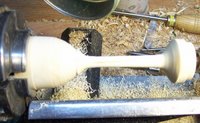Vine Maple Goblet
On Wood Central’s Turning Forum Steven Lewis asked about turning goblets from green wood. I decided to give it a try using the alcohol drying method. The only green wood readily available to me is vine maple.
 The limb was about 2 ½" in diameter. As you can see the limb was not straight so I expected the stem would warp when drying.
The limb was about 2 ½" in diameter. As you can see the limb was not straight so I expected the stem would warp when drying.
The roughed out goblet is about 2" in diameter and 6" long. and the stem is ½" in diameter.

The piece soaked over night for my convenience. An hour or two in the alcohol would have probably been sufficient. After removing from the soaking container the goblet is wrapped in paper leaving the bowl uncovered.
Weight in Grams.
11/20 - 1000 - 143
11/21 - 0830 - 117
11/22 - 0700 - 110
11/24 - 2130 - 106
11/25 - 1230 - 106
11/25 - 2100 - 105
11/26 - 1300 - 106
11/27 - 1100 - 105
At 10:00AM November 20th the goblet weighed 143g. Four and a half days later it weighed 106g. By the 27h it hadn’t lost anymore weight so I finished turned the goblet.
 With the tool rest set at the center line I adjusted the goblet to have the stem centered.
With the tool rest set at the center line I adjusted the goblet to have the stem centered.
 The limb was about 2 ½" in diameter. As you can see the limb was not straight so I expected the stem would warp when drying.
The limb was about 2 ½" in diameter. As you can see the limb was not straight so I expected the stem would warp when drying.The roughed out goblet is about 2" in diameter and 6" long. and the stem is ½" in diameter.

The piece soaked over night for my convenience. An hour or two in the alcohol would have probably been sufficient. After removing from the soaking container the goblet is wrapped in paper leaving the bowl uncovered.
Weight in Grams.
11/20 - 1000 - 143
11/21 - 0830 - 117
11/22 - 0700 - 110
11/24 - 2130 - 106
11/25 - 1230 - 106
11/25 - 2100 - 105
11/26 - 1300 - 106
11/27 - 1100 - 105
At 10:00AM November 20th the goblet weighed 143g. Four and a half days later it weighed 106g. By the 27h it hadn’t lost anymore weight so I finished turned the goblet.
 With the tool rest set at the center line I adjusted the goblet to have the stem centered.
With the tool rest set at the center line I adjusted the goblet to have the stem centered.



























